Avoid getting scammed by spam claiming that your email is compromised
Phishing/ScamAlso Known As: Your Email Will Be Suspended spam
Get free scan and check if your device is infected.
Remove it nowTo use full-featured product, you have to purchase a license for Combo Cleaner. Seven days free trial available. Combo Cleaner is owned and operated by RCS LT, the parent company of PCRisk.com.
What is "Your email will be suspended Scam"?
"Your email will be suspended Scam" refers to a spam campaign. These letters are presented as notifications concerning an impending suspension of the recipients' email accounts due to detected suspicious activity. The goal of the scam emails is to trick users into attempting to sign into their email accounts via a phishing website.
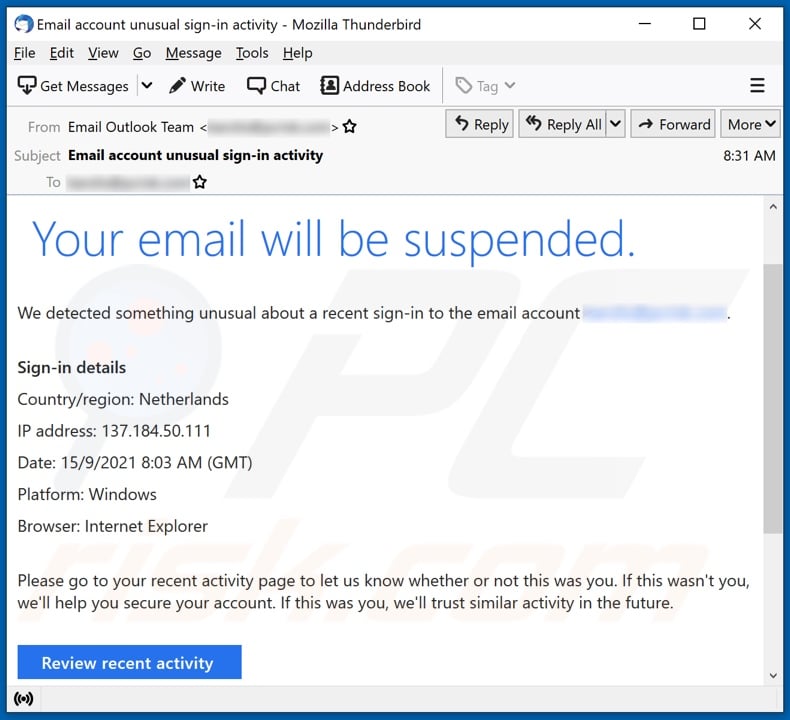
"Your email will be suspended Scam" in detail
The scam emails claim that an unusual sign-in had occurred on recipients' email accounts. They are asked to verify whether it was them or the accounts will be suspended due to being compromised. It must be emphasized that these letters are fake; hence, no suspect activity has taken place on recipients' email accounts.
The spam emails aim to promote a phishing site, which targets email log-in credentials (i.e., passwords). If attempts to sign in through this webpage have already been made, it is crucial to immediately change the log-in credentials of all potentially compromised accounts.
Scammers primarily target emails as they are usually connected with other accounts, platforms, and services. Therefore, through emails - control may be gained over content associated with them.
Hijacked communication accounts (e.g., email, social networking, etc.) can be used to steal the owner's identity and ask their contacts for loans or donations. These platforms can also be used to proliferate malware (by sharing malicious files/links). Stolen finance-related accounts (e.g., online banking, e-commerce, etc.) can be used to make fraudulent transactions and/or online purchases.
To summarize, by trusting these scam emails, users can lose various accounts/platforms, and experience severe privacy issues, financial losses, and identity theft.
| Name | Your email will be suspended Scam |
| Threat Type | Phishing, Scam, Social Engineering, Fraud |
| Fake Claim | Scam emails claim that a suspicious log-in has been detected on recipients' email accounts. |
| Symptoms | Unauthorized online purchases, changed online account passwords, identity theft, illegal access of the computer. |
| Distribution methods | Deceptive emails, rogue online pop-up ads, search engine poisoning techniques, misspelled domains. |
| Damage | Loss of sensitive private information, monetary loss, identity theft. |
| Malware Removal (Windows) |
To eliminate possible malware infections, scan your computer with legitimate antivirus software. Our security researchers recommend using Combo Cleaner. Download Combo CleanerTo use full-featured product, you have to purchase a license for Combo Cleaner. 7 days free trial available. Combo Cleaner is owned and operated by RCS LT, the parent company of PCRisk.com. |
Spam campaigns in general
"Account Security Info Update", "Gas Sensing Solutions (GSS) email scam", "Storage Server Failure" - are a few examples of phishing spam campaigns. Deceptive letters can use various scam models and disguises to gain and abuse users' trust. In addition to phishing and other scams, spam mail is also used to spread malware (e.g., ransomware, trojans, etc.).
How do spam campaigns infect computers?
Spam campaigns proliferate malware via infectious files, which can be attached to and/or linked inside the scam emails. These files can be in various formats, e.g., Microsoft Office and PDF documents, archives, executables, JavaScript, etc. When the files are opened - the infection chain is initiated.
For example, Microsoft Office documents cause infections by executing malicious macro commands. This occurs when a document is opened in Microsoft Office versions released prior to 2010. Later versions have "Protected View" mode that prevents this; instead, users can manually enable macros (i.e., editing/content).
How to avoid installation of malware?
It is advised to exercise caution with incoming emails and avoid opening dubious or irrelevant ones. The attachments or links found in such emails must not be opened, as that can result in a system infection. It is also recommended to use Microsoft Office versions released after 2010.
Other malware distribution methods include: untrustworthy download channels (e.g., unofficial and freeware sites, Peer-to-Peer sharing networks, etc.), illegal activation tools ("cracks"), and fake updates. Therefore, it is important to always download from official/verified sources and activate/update programs with tools provided by genuine developers.
It is paramount to have a reputable anti-virus installed and updated. This software has to be used to run regular system scans and to remove threats. If you've already opened malicious attachments, we recommend running a scan with Combo Cleaner Antivirus for Windows to automatically eliminate infiltrated malware.
Text presented in the "Your email will be suspended" scam email letter:
Subject: Email account unusual sign-in activity
Your email will be suspended.
We detected something unusual about a recent sign-in to the email account ********.Sign-in details
Country/region: Netherlands
IP address: 137.184.50.111
Date: 15/9/2021 8:03 AM (GMT)
Platform: Windows
Browser: Internet Explorer
Please go to your recent activity page to let us know whether or not this was you. If this wasn't you, we'll help you secure your account. If this was you, we'll trust similar activity in the future.
Review recent activity
To opt out or change where you receive security notifications, click here.
Thanks,
Email Outlook™ Team
This message is auto-generated from E-mail security server, and replies sent to this email can not be delivered.This email is meant for: ********
Appearance of the "Your email will be suspended" scam email (GIF):
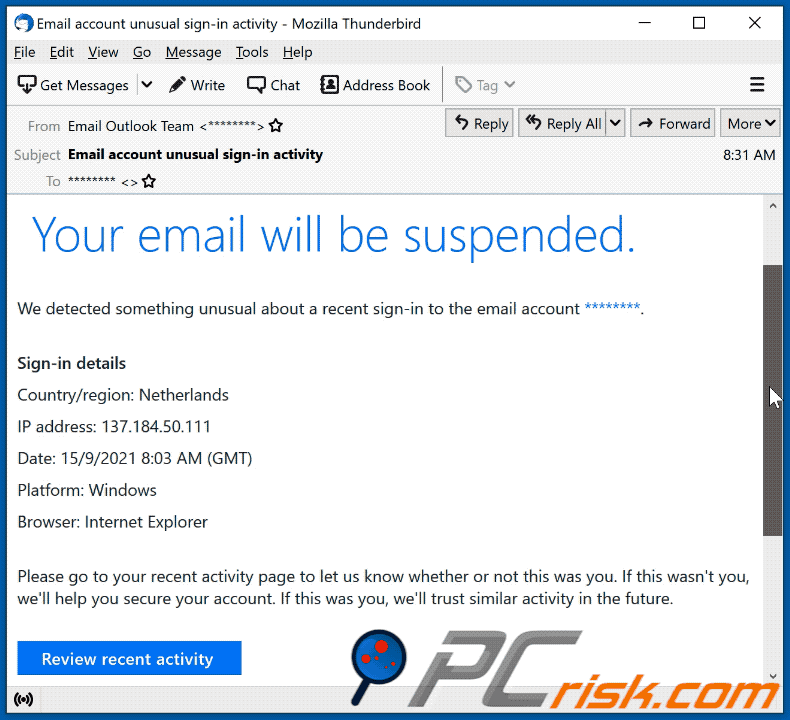
Screenshots of the phishing websites promoted by the "Your email will be suspended" spam campaign:
Another example of email suspension-themed spam:
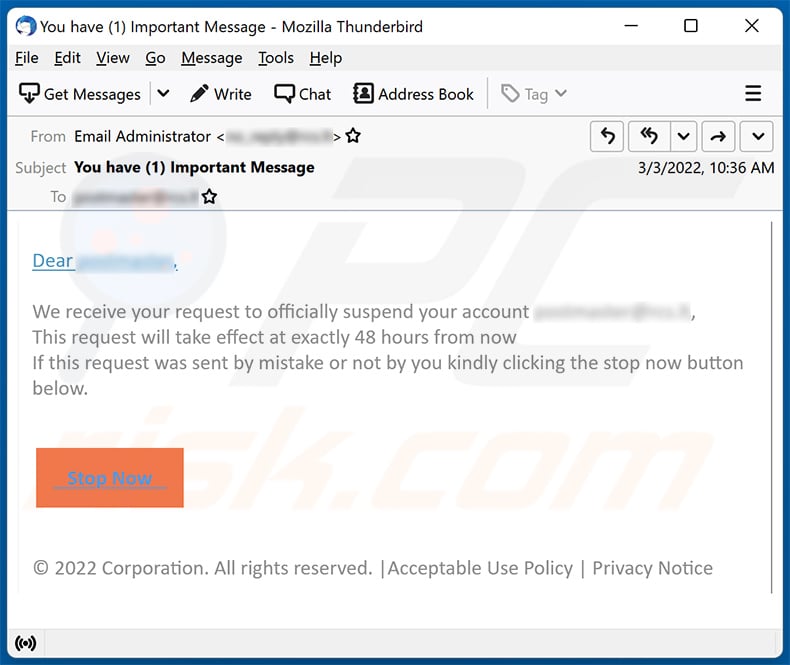
Text presented within:
Subject: You have (1) Important Message
>
>
> Dear postmaster,
>
> We receive your request to officially suspend your account -,
> This request will take effect at exactly 48 hours from now
> If this request was sent by mistake or not by you kindly clicking the stop now button below.
>
>
>
> Stop Now
>
>
> © 2022 Corporation. All rights reserved. |Acceptable Use Policy | Privacy Notice
Screenshot of the promoted phishing site:
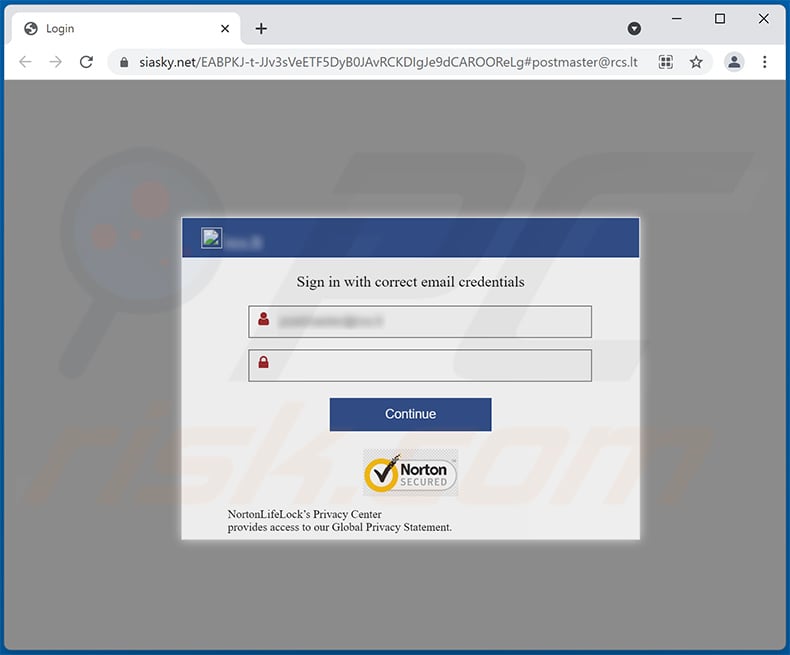
Instant automatic malware removal:
Manual threat removal might be a lengthy and complicated process that requires advanced IT skills. Combo Cleaner is a professional automatic malware removal tool that is recommended to get rid of malware. Download it by clicking the button below:
DOWNLOAD Combo CleanerBy downloading any software listed on this website you agree to our Privacy Policy and Terms of Use. To use full-featured product, you have to purchase a license for Combo Cleaner. 7 days free trial available. Combo Cleaner is owned and operated by RCS LT, the parent company of PCRisk.com.
Quick menu:
- What is Your Email Will Be Suspended spam?
- Types of malicious emails.
- How to spot a malicious email?
- What to do if you fell for an email scam?
Types of malicious emails:
![]() Phishing Emails
Phishing Emails
Most commonly, cybercriminals use deceptive emails to trick Internet users into giving away their sensitive private information, for example, login information for various online services, email accounts, or online banking information.
Such attacks are called phishing. In a phishing attack, cybercriminals usually send an email message with some popular service logo (for example, Microsoft, DHL, Amazon, Netflix), create urgency (wrong shipping address, expired password, etc.), and place a link which they hope their potential victims will click on.
After clicking the link presented in such email message, victims are redirected to a fake website that looks identical or extremely similar to the original one. Victims are then asked to enter their password, credit card details, or some other information that gets stolen by cybercriminals.
![]() Emails with Malicious Attachments
Emails with Malicious Attachments
Another popular attack vector is email spam with malicious attachments that infect users' computers with malware. Malicious attachments usually carry trojans that are capable of stealing passwords, banking information, and other sensitive information.
In such attacks, cybercriminals' main goal is to trick their potential victims into opening an infected email attachment. To achieve this goal, email messages usually talk about recently received invoices, faxes, or voice messages.
If a potential victim falls for the lure and opens the attachment, their computers get infected, and cybercriminals can collect a lot of sensitive information.
While it's a more complicated method to steal personal information (spam filters and antivirus programs usually detect such attempts), if successful, cybercriminals can get a much wider array of data and can collect information for a long period of time.
![]() Sextortion Emails
Sextortion Emails
This is a type of phishing. In this case, users receive an email claiming that a cybercriminal could access the webcam of the potential victim and has a video recording of one's masturbation.
To get rid of the video, victims are asked to pay a ransom (usually using Bitcoin or another cryptocurrency). Nevertheless, all of these claims are false - users who receive such emails should ignore and delete them.
How to spot a malicious email?
While cyber criminals try to make their lure emails look trustworthy, here are some things that you should look for when trying to spot a phishing email:
- Check the sender's ("from") email address: Hover your mouse over the "from" address and check if it's legitimate. For example, if you received an email from Microsoft, be sure to check if the email address is @microsoft.com and not something suspicious like @m1crosoft.com, @microsfot.com, @account-security-noreply.com, etc.
- Check for generic greetings: If the greeting in the email is "Dear user", "Dear @youremail.com", "Dear valued customer", this should raise suspiciousness. Most commonly, companies call you by your name. Lack of this information could signal a phishing attempt.
- Check the links in the email: Hover your mouse over the link presented in the email, if the link that appears seems suspicious, don't click it. For example, if you received an email from Microsoft and the link in the email shows that it will go to firebasestorage.googleapis.com/v0... you shouldn't trust it. It's best not to click any links in the emails but to visit the company website that sent you the email in the first place.
- Don't blindly trust email attachments: Most commonly, legitimate companies will ask you to log in to their website and to view any documents there; if you received an email with an attachment, it's a good idea to scan it with an antivirus application. Infected email attachments are a common attack vector used by cybercriminals.
To minimise the risk of opening phishing and malicious emails we recommend using Combo Cleaner Antivirus for Windows.
Example of a spam email:

What to do if you fell for an email scam?
- If you clicked on a link in a phishing email and entered your password - be sure to change your password as soon as possible. Usually, cybercriminals collect stolen credentials and then sell them to other groups that use them for malicious purposes. If you change your password in a timely manner, there's a chance that criminals won't have enough time to do any damage.
- If you entered your credit card information - contact your bank as soon as possible and explain the situation. There's a good chance that you will need to cancel your compromised credit card and get a new one.
- If you see any signs of identity theft - you should immediately contact the Federal Trade Commission. This institution will collect information about your situation and create a personal recovery plan.
- If you opened a malicious attachment - your computer is probably infected, you should scan it with a reputable antivirus application. For this purpose, we recommend using Combo Cleaner Antivirus for Windows.
- Help other Internet users - report phishing emails to Anti-Phishing Working Group, FBI’s Internet Crime Complaint Center, National Fraud Information Center and U.S. Department of Justice.
Frequently Asked Questions (FAQ)
Why did I receive this email?
Spam emails are sent in massive numbers; they are not personal. The scam works with the hope that some of the recipients will fall for it.
I have provided my personal information when tricked by this spam email, what should I do?
All of the exposed log-in credentials (passwords) must be changed immediately. It is also recommended to contact the official support of all potentially compromised accounts. Contact the relevant authorities without delay if you've also disclosed other personal information (e.g., credit card numbers, ID card details, etc.).
I have read a spam email but didn't open the attachment, is my computer infected?
No, systems are infected when spam email attachments or links are opened; reading the email itself will not trigger malware download/installation.
I have downloaded and opened a file attached to a spam email, is my computer infected?
If the opened attachment was an executable file - then, very likely, - yes, your system has been infected. However, other file formats (e.g., .pdf, .doc, and other documents) often require additional action to initiate the infection processes. Therefore, simply opening a virulent document may not have resulted in a system infection.
Will Combo Cleaner remove malware infections present in email attachments?
Yes, Combo Cleaner is able to detect and eliminate almost all known malware infections. It is worth noting that high-end malware can be hidden deep within the system - which necessitates a full system scan for successful removal.
Share:

Tomas Meskauskas
Expert security researcher, professional malware analyst
I am passionate about computer security and technology. I have an experience of over 10 years working in various companies related to computer technical issue solving and Internet security. I have been working as an author and editor for pcrisk.com since 2010. Follow me on Twitter and LinkedIn to stay informed about the latest online security threats.
PCrisk security portal is brought by a company RCS LT.
Joined forces of security researchers help educate computer users about the latest online security threats. More information about the company RCS LT.
Our malware removal guides are free. However, if you want to support us you can send us a donation.
DonatePCrisk security portal is brought by a company RCS LT.
Joined forces of security researchers help educate computer users about the latest online security threats. More information about the company RCS LT.
Our malware removal guides are free. However, if you want to support us you can send us a donation.
Donate
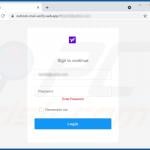

▼ Show Discussion